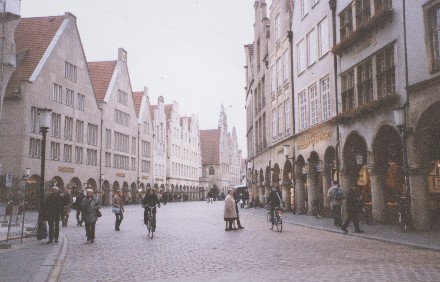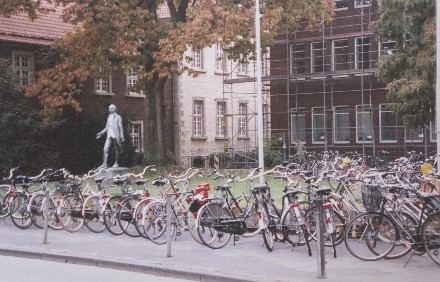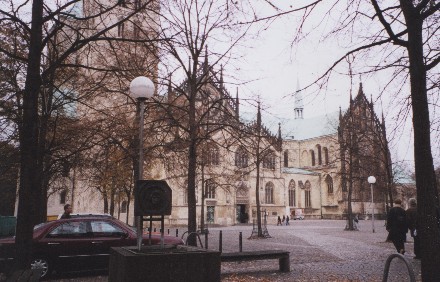Munster, Germany, October 2003

Munster Town Centre
In October 2003, Sijiong, David, Clare and Heather travelled to the 4th International Workshop on Adaptive Optics in Industry and Medicine in Munster, Germany. They spent a week in total in the beautiful town in Northern Germany enjoying the delicious steak and tasty local beer!
The first thing you notice on arrival is the vast amount of bicycles and bicycle paths. During World War II the city center was almost completely destroyed. In the reconstruction of the city after the war it was decided that bicycles and buses should be an important part of city traffic. For the past 50 years the city has continually worked on increasing bicycle use. Munster has a population of 280,000 and there are actually more bicycles than people! 43% of trips in the city centre are made by bike, making Munster a worldwide model for a greener city.

Students' bicycles outside one of Munster University's lecture halls
Munster has a very interesting past, which was related to us by the local guide during the city tour arranged by the conference organisers. Munster was the site of a famous religious rebellion, in which a sect of Anabaptists took over the town. They convinced many of the locals that the end of the world was approaching and only those people living in Munster, who followed the Anabaptists, would survive. A bloody period of the town's history ensued; citizens were made to choose between baptism and death. Unsurprisingly many chose baptism. The Anabaptists seized the town's wealth and instituted a communist like system of distribution. In 1534 Jan Matthys, the leader of the movement, following a "divine revelation" took 20 men to fight the armies that were laying siege to Munster and they were all killed. John of Leyden, Jan's right hand man, then declared himself King and introduced polygamy (despite the strong opposition of 200 of the Anabaptists and over the dead bodies of 50 of them!).
After a year long siege the city was retaken by the army of the Bishop. The 'king' of Munster, his second in command and his executioner were tried and then publicly tortured to death. Their bodies were placed in iron cages in plain view in the bell tower of St Lamberts in Munster. This was done as a warning to others who might think of rebelling again, and also so there would be no chance that their bodies would end up buried in consecrated ground. Their cages are empty now, but only because over time the bones fell out. The original cages were taken down for their protection during WWII and re-hung shortly after. Munster is now renowned for its love of modern art, and in keeping with this the cages now contain lights as a symbol that ideas cannot be bound by bars.

Munster Cathedral which houses an incredible (and fully working) astronomical clock.
back to top
Just for fun
A little peek into the lighter side of life within the Heriot-Watt Waves & Fields group.
Word of the Week:
Gallivanting
Or: